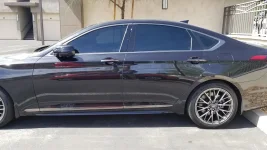Just curious, what is the difference between a ceramic vs carbon tint? Is it just looks, or is the material actually different?
I've only tinted one of my cars in the past. Never really cared about it until more recently, thus I really don't know much about it.
Years ago, 3M had a tint film (mostly for commercial and residential buildings) that had metallic particles imbedded in it, that reflects heat and solar energy. I am not sure if they invented it, but maybe. The tiny bits of metal in the films did a great job of reflecting heat, and made the film a little darker.
Before metallic tint films were dyed films. Merely having a dark color film that contains dyes, does cut down on the sunlight somewhat that reaches the interior of the car, but it actually absorbs heat on the glass it is attached to, and does not
reflect either sunlight or solar energy (none visible spectrum). Also, dyed films were notorious for them eventually fading (which most people of a certain age group would know about because it could be seen all over the place).
Carbon films are like dyed film in that they just make the glass darker, but don't reflect much heat. However, they do significantly (if not totally) cure the problem of fading. They have tiny bits of carbon material in them to make them look smoky, but are not technically dyed.
When personal electronics came along, and when car radio antenna were no longer outside the car on a stick, metallic tint films became a problem in that they cut down on radio and other electronic transmissions. That is why
ceramic films were developed. The contain tiny bits of
ceramic material that reflects heat and solar radiation almost as well as metal, but does not block electronic transmissions.
There are also some hybrid tint films, that may be part carbon and part
ceramic (or metal), to give the "cool" look of smoked glass tint film, but also with improved solar energy reflection.
For someone living in Canada or the northern US, and are looking for the aesthetics of a smoked glass look that provides privacy, a carbon film might be a good choice. Those looking for superior heat and solar energy protection should probably choose
ceramic instead.
For a given VLT rating (check the actual rating, not just the model number, since a XXX-30 film may actually have a VLT of 27 or so, or even 33) a pure
ceramic films will have better heat rejection than the same VLT carbon or dyed film. But
ceramic does have a slight reflective visual effect that some don't like as well as the smoked look of a carbon or dyed film.












